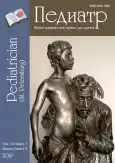The role of local anesthesia to reduce pain after PСNL
- Authors: Popov S.V1, Orlov I.N1, Obidnyak V.M1, Malevich S.M1, Borichev M.V1, Basok S.M1, Gadzhiev N.K2, Tagirov N.S3, Pisarev A.V4, Malkhasyan V.A5, Mazurenko D.A6
-
Affiliations:
- St Petersburg St Luka Clinical Hospital
- Nikiforov Russian Center of Emergency and Radiation Medicine
- St Petersburg St Elisabeth City Hospital
- St Petersburg Multiprofile Center, Ministry of Health of Russian Federation
- Moscow State Medical Stomatological University named after A.I. Evdokimov
- Urologic Clinic EMC
- Issue: Vol 7, No 4 (2016)
- Pages: 113-118
- Section: Articles
- URL: https://journals.eco-vector.com/pediatr/article/view/5976
- DOI: https://doi.org/10.17816/PED74113-118
- ID: 5976
Cite item
Abstract
The goal of the study was to assess the level of postoperative pain in patients undergoing PCNL after paratubal infiltration with local anesthetic to compare this method of anesthesia with a control group where local anesthesia was not provided. 63 patients were included with kidney stones, confirmed by computer tomography (CT), who were planned to undergo percutaneous nephrolithitomy (PСNL). During the observation 6 patients have been excluded in accordance with the exclusion criteria. The remaining 57 patients were randomized into 2 groups: group A (n= 28) at the end of the operation received paratubal infiltration of 0.5% sol. ropivacaine; group B (n= 29) (controls) — local anesthesia was not used. Postoperative pain was assessed by means of VAS-score 1 hour, 6 hours and 24 hours after surgery. Systemic analgesia was performed with NSAIDs (intramuscular injection of 100 mg ketoprofen) when requested by the patient (Patient-Controlled Analgesia). In patients with local anesthesia, the total VAS score evaluated after 1 and 6 hours after the operation was significantly lower than in the control group. The average amount of ketoprofen required for postoperative analgesia in the group of patients with paratubal infiltration was significantly lower than in the control group. Paratubal infiltration of local anesthetic after PCNL significantly reduced postoperative pain and tended to reduce the amount of NSAIDs to eliminate pain, which in turn may reduce the risk of complications associated with NSAID.
Keywords
Full Text
About the authors
Sergei V Popov
St Petersburg St Luka Clinical Hospital
Author for correspondence.
Email: doc.popov@gmail.com
MD, PhD, Dr. Med. Sci., Head Doctor Russian Federation
Igor N Orlov
St Petersburg St Luka Clinical Hospital
Email: doc.orlov@gmail.com
urologist, MD, PhD. Director of urologic department Russian Federation
Vladimir M Obidnyak
St Petersburg St Luka Clinical Hospital
Email: v.obidniak@gmail.com
MD, urologist. Department of Urology Russian Federation
Sergey M Malevich
St Petersburg St Luka Clinical Hospital
Email: malevichsm@gmail.com
MD, urologist. Department of Urology Russian Federation
Maxim V Borichev
St Petersburg St Luka Clinical Hospital
Email: medmaxx3@bk.ru
MD, urologist. Department of Urology Russian Federation
Stanislav M Basok
St Petersburg St Luka Clinical Hospital
Email: stas_basok@mail.ru
MD, urologist. Department of Urology Russian Federation
Nariman K Gadzhiev
Nikiforov Russian Center of Emergency and Radiation Medicine
Email: nariman.gadjiev@gmail.com
urologist, MD, PhD. Department of Urology Russian Federation
Nair S Tagirov
St Petersburg St Elisabeth City Hospital
Email: ruslana73nair@mail.ru
MD, PhD, urologist Russian Federation
Alexey V Pisarev
St Petersburg Multiprofile Center, Ministry of Health of Russian Federation
Email: alexey.v.pisarev@gmail.com
MD, urologist, Department of Urology Russian Federation
Vigen A Malkhasyan
Moscow State Medical Stomatological University named after A.I. Evdokimov
Email: vigenmalkhasyan@gmail.com
urologist, MD, PhD. Department of Urology Russian Federation
Denis A Mazurenko
Urologic Clinic EMC
Email: d.a.mazurenko@gmail.com
urologist, MD, PhD. Vice Director of Urologic Clinic Russian Federation
References
- Григорьев Н.А., Семенякин И.В., Гаджиев Н.К., и др. Мочекаменная болезнь // Урология. – 2016. – № 52. – С. 37–69. [Grigorev NA, Semenyakin IV, Gadzhiev NK, et al. Mochekamennaya bolezn. Urologiya. 2016;(52):37-69. (In Russ.)]
- Хасигов А.В., Белоусов И.И., Коган М.И. Сравнительный анализ эффективности и безопасности нефролитотомии при коралловидных камнях // Урология. – 2013. – № 1. – С. 86–88. [Hasigov AV, Belousov II, Kogan MI. Comparative assessment of percutaneous nephrolitotomia effectiveness in case of corral-like stones. Urologiya. 2013;(1):86-88. (In Russ.)]
- Ak K, et al. Thoracic paravertebral block for postoperative pain management in percutaneous nephrolithotomy patients: a randomized controlled clinical trial. Medical principles and practice. International Journal of the Kuwait University, Health Science Centre. 2013;22(3):229-33.
- Desai Mahesh R, et al. A prospective randomized comparison of type of nephrostomy drainage following percutaneous nephrostolithotomy: large bore versus small bore versus tubeless. The Journal of Urology. 2004;172(2):565-67. doi: 10.1097/01.ju.0000130752.97414.c8.
- Fernström I, Johansson B. Percutaneous Pyelolithotomy. A new extraction technique. Scandinavian Journal of Urology and Nephrology. 1976;10(3):257-59.
- Gadsen J. Local anesthetics for peripheral nerve block. The New York School of Regional Anesthesia. 2013.
- Honey R, et al. A randomized, double-blinded, placebo-controlled trial of intercostal nerve block after percutaneous nephrolithotomy. Journal of Endourology. 2013;27(4):415-19. doi: 10.1089/end.2012.0418.
- Jonnavithula Nirmala, et al. Efficacy of Peritubal Local Anesthetic Infiltration in Alleviating postoperative pain in percutaneous nephrolithotomy. Journal of Endourology. Endourological Society. 2009;23(5):857-60. doi: 10.1089/end.2008.0634.
- Joshi Girish P. Multimodal analgesia techniques and postoperative rehabilitation. Anesthesiology Clinics of North America. 2005:23(1):185-202. doi: 10.1016/j.atc.2004.11.010.
- Kim Samuel C, William W. Tinmouth, Ramsay L. Kuo. Using and choosing a nephrostomy tube after percutaneous nephrolithotomy for large or complex stone disease: a treatment strategy. Journal of Endourology. Endourological Society. 2005;19(3):348-52. doi: 10.1089/end.2005.19.348.
- Patel Sutchin R, Stephen Y. Nakada. The modern history and evolution of percutaneous nephrolithotomy. Journal of Endourology. Endourological Society. 2015;29(2):153-57. doi: 10.1089/end.2014.0287.
- Shen Pengfei, Yong Liu, Jia Wang. Nephrostomy tube-free versus nephrostomy tube for renal drainage after percutaneous nephrolithotomy: a systematic review and meta-analysis. Urologia Internationalis. 2012;88(3):298-306. doi: 10.1159/000332151.
- Türk Christian, et al. EAU guidelines on interventional treatment for urolithiasis. European Urology. 2016;69(3):475-82. doi: 10.1016/j.eururo.2015.07.041.
- Ugras Murat Yahya, Huseyin Ilksen Toprak, Hakan Gunen, et al. Instillation of skin, nephrostomy tract, and renal puncture site with ropivacaine decreases pain and improves ventilatory function after percutaneous nephrolithotomy. Journal of Endourology. Endourological Society. 2007;21(5):499-503. doi: 10.1089/end.2006.0335.
Supplementary files









